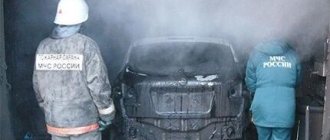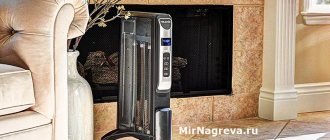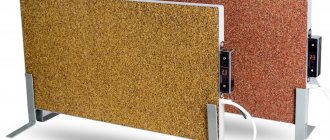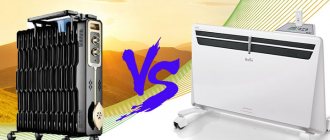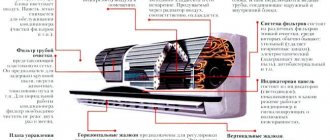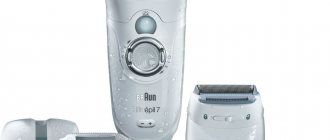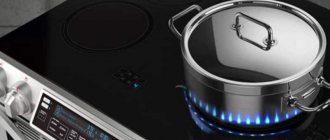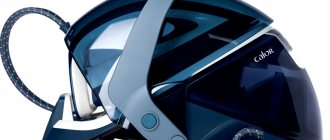Additional heat sources most often turn out to be relevant in conditions where the possibility of installing heating systems is not provided. There are many alternative offers on the market, among which the favorites stand out. One of the main dilemmas is the question: what is better to choose, a heat gun or an infrared heater? Let's try to solve it.
Features of the devices
The task of both devices is to create a comfortable and warm atmosphere in the room. But the principle of achieving the goal will be different. It's all about the peculiarities of the functioning of the technology.
Heat gun
There are many types of such devices, each differing only in the type of fuel used. Most often they use fire or electricity. All of them have one thing in common - heating will be supplied under pressure from the air masses. In practice, working “with fire” will look like this:
- A jet of fuel is supplied under pressure into the combustion chamber.
- The fan creates a flow of air that is directed to already heated heat sources.
- The air heats up to about 200 degrees. The temperature of the chamber itself at that moment reaches 800 degrees.
- The jet burns in the air flow.
- The waste product (carbon monoxide) is removed into the chimney pipe.
- Electricity is used, which is needed to rotate the engine fan and fuel pump.
It is very important to take into account all fire safety rules during installation.
The device can also be powered by current. If a heat gun is used as an electric heater, then it is quite suitable for residential premises (being safer in everyday life). Only in this case, heating elements made of ceramics and stainless steel are used.
A heat gun heats a room with point-by-point, constant blows. Instead of cores, it uses air currents. The operating power allows you to warm up large areas of the room in a matter of minutes.
Operating principle of a heat gun
Infrared equipment
The operation of an infrared radiation source is based on the action of electromagnetic waves. They have a certain length that corresponds to the spectrum. An interesting fact is that the effect will only be on non-reflective objects - if the surface turns out to be shiny, white and transparent, it will remain cold.
The air itself will then be heated by objects - and this is a big plus of the device. Even after turning off the device, the atmosphere will remain pleasantly warm for a long time (ventilating the room will not interfere with this). This means we can talk about saving energy costs spent on heating.
There are other advantages to using such effective devices:
- environmental friendliness (oxygen is not burned and there is no unpleasant odor);
- ease of installation;
- versatility and aesthetics.
However, there are some downsides - as soon as you step out of your comfort zone, you feel cold. And if such an IR heater is placed incorrectly, then a headache may occur. It appears due to resonances of the thermal zones of the body, especially when only one part of it is heated. But doctors are simply sure that it is precisely such devices that are the culprits of dry skin and question the safety of staying near infrared radiation for a long time.
Operating principle of an infrared heater
Heat gun or convector: what to choose
The level of comfort in a room depends on the temperature. Also, if the house is not warmed up enough, there is a risk of developing various diseases. An additional heater is an effective solution to the problem. But what to choose – a convector or a heat gun?
CONVECTOR
Operating principle. It is based on natural convection: cold air enters the device from below, then passes through the heating element and is released from the top (side).
Advantages:
- no oxygen combustion;
- affordable price;
- adjustable temperature;
- compact dimensions, possibility of mounting on the wall;
- possibility of using several convectors in one circuit at once.
There is only one minus - slow heating. You will have to wait quite a long time for the cold room to warm up. In urban environments, convectors are installed mainly in the bathroom. Outside the city, they are mounted in the floor or window sill (this way they can get rid of drafts). Also, interconnected convectors can completely heat the cottage.
HEAT GUNS
Operating principle. The distinctive element of a heat gun is the fan. It creates high-speed currents and sends hot air into the environment. As a rule, heat guns are superior in power to any other type of heater. They operate on various types of fuel, but when comparing with a convector, we will focus on electric models.
Advantages:
- quick heating of the room;
- long service life;
- increased design reliability;
- mobility;
- unpretentiousness in maintenance.
The main problem is that the gun cannot maintain the temperature if it is turned off (unlike a convector). Therefore, in terms of energy consumption, such a heater will bring considerable costs. Also, be prepared for a lot of noise.
Thanks to their ability to quickly heat large areas, heat guns have found use on construction sites, workshops, greenhouses, warehouses, etc. As for private use, they will be useful in garages, basements, and also in the country.
Catalog of heat guns: /otopitelnoe-oborudovanie/teplovye-pushki.html
Catalog of electric convectors:
/otopitelnoe-oborudovanie/konvektory-jelektricheskie.html
Haven't made your choice yet? Take a look at the heating equipment catalogue.
Other articles:
- Corner or rectangular shower cabin: what to choose
- Differences between a kitchen faucet and a bathroom faucet
- Floor-mounted or wall-mounted toilet. What to choose?
- Heated towel rail: water or electric
- What to choose: bath or shower
Scope of application of heat guns
Not all objects can be heated (and in some cases, for example, in open spaces, it is even pointless to do this). A heat gun can help out here.
The fuel used imposes some restrictions on the scope of application of such devices. This is especially clearly seen in the case of gas options - they are used in rooms where people are not constantly present. Most often these are warehouses, industrial premises, trading floors, pavilions and construction sites.
Electrical units also have their own specifics. First of all, we must remember the high cost of electricity - it is rational to use them only for local heating or in rooms with a small square footage. For the latter case, compact models are used (the device will have a power of only 2-3 kW). There is also a limitation on the temperature range - from -10 to 35°C, which you also need to pay attention to.
Advantages and disadvantages of heat guns
The main advantage of these devices is their high strength and long service life. They can be in use for weeks. As a rule, their metal body is extremely reliable and eliminates any mechanical failures. In addition, heat guns are portable devices and are very easy to maintain. These qualities have made their use popular in a variety of fields.
The fan operating mode without heating significantly increases the operating life of the device.
But a heat gun emits warm air into space only during its operation. If you pause the operation of the device, the temperature in the room will begin to steadily decrease. Therefore, to constantly maintain a comfortable temperature, significant energy consumption will be required.
Possibility of using infrared heaters
Such equipment can run on electricity, gas, and even liquid (for example, diesel) fuel. Each type is good for a specific area of application.
- For example, a gas or liquid fuel model can be used in cases where heating of open areas is needed, for example, an outdoor cafe or a children's playground. For an area of 25 square meters, a device with medium power is quite suitable. The radiation in such models will be quite high-energy, so it is better for people to stay in such a room for a short time.
- The electric option is more suitable for home use - here the heating element will operate at a low temperature. And the waves produced are similar in length to those emitted by people themselves. The bonus will be the absolute durability and safety of its service.
Experts advise installing an infrared heater on the ceiling or other maximum elevation of the serviced area. This will help the emitters heat more space, and not just those objects that are encountered “on the way.”
Heat gun - operating principle, types
This is a device for heating a room in which heated air is forced into the room under the influence of a fan.
Depending on the heating source, heat guns are divided into:
- Gas - run on gas in cylinders or from a centralized gas pipeline.
- Diesel - heat the air using the energy of combustion of diesel fuel.
- Multi-fuel - make it possible to use different energy carriers (gas, diesel fuel, kerosene).
- Electrical - work by converting electrical energy into thermal energy.
Gas and diesel guns require a chimney in the room to remove the generated smoke and supply electricity to operate the fuel pump and fan.
How to choose the right device
It doesn’t matter which source the consumer chooses. The main thing is quality products. You can’t “look” at the low cost - such savings are absolutely not justified, since the product will be filled with low-quality wires and poor contacts. Quality products can be determined by the following characteristics:
- strong and reliable body;
- thick insulated cable;
- great fork.
Questionable devices not only carry the risk of quickly failing, but the main danger here is the possibility of a short circuit. The consequence could be a fire, so you shouldn’t skimp on your own life.
Efficiency comparison test
Users’ doubts about choosing a certain type of device are understandable. To understand this point, you can compare the rate of heating of the atmosphere in a certain area of space. Take, for example, a 20 square meter insulated garage in the winter. The object is interesting because there are no other specially connected heating networks here, so we will work “from scratch.” Since the ventilation is blocked, it is best to use electric versions of both devices.
Heat gun Bau Master
The Bau Master heat gun (made in Russia) and the popular Chinese infrared heater Ballu BHH/M-09 are taking part in the “competition”. The results can be seen in the comparison table:
| Heat gun Bau Master, 3000 W | Infrared heater Ballu BHH/M-09, 900 W, 4 pieces, hanging from the ceiling on opposite walls | ||
| Conditions | Result | Conditions | Result |
| Outside 0, inside + 18 | Warming up took place within 30-40 minutes. | Outside -14, inside +14 | Warming up the entire room took half an hour, but the comfort of being in the affected area occurs after 10 seconds. |
| Outside – 5, inside + 15 | The room warmed up within 1 hour. | Outside – 21, in the garage it’s +8, together it’s + 10 | It took 1 hour to create a warm atmosphere in the entire room, but within a meter radius of the heater it was immediately warm. |
| Outside - 20, inside 0, in the end it turned out to be + 5 degrees. | Warming up occurs within an hour and a half, but it is impossible to work in such a room in the future. | ||
| The joint operation of both devices will give + 20 inside the garage with - 20 outside, but you should immediately prepare for large electricity bills. | |||
Of course, this experiment is far from an ideal indicator of work, but, nevertheless, conclusions can already be drawn. Each consumer himself orients himself on which unit to use, based on the parameters and purpose of the room, the desired heating speed, the power of the equipment and other relevant indicators.
